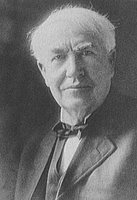 Thomas Alva Edison was not only a great inventor, but an inspired businessman. His entrepreneurial talent first showed itself about the age of 12, when he obtained the concession to sell newspapers and confectionery on the train running between Port Huron and Detroit, Michigan.
Thomas Alva Edison was not only a great inventor, but an inspired businessman. His entrepreneurial talent first showed itself about the age of 12, when he obtained the concession to sell newspapers and confectionery on the train running between Port Huron and Detroit, Michigan.His profit on newspapers depended on exactly matching supply to demand. So, with charqacteristic enterprise, he persuaded a friend who worked on the Detroit Free Press to show him proofs of the lead stories in advance, so he could estimate the probable level of public interest and thus sales for the day.
His greatest triumph as a newsboy came in April 1862, when the first accounts of the bloody Civil War battle of Shiloth hit the headlines. Seeing the chance to make money, Edison bought 1000 copies of the Detroit Free Press on credit and arranged for news of the battle to be telegraphed up the line ahead of the train and posted in the stations.
Word spread fast through each small town and crowds packed the stations, frantic to read more details of the fighting when the newspapers arrived. Edison was able not only to sell all 1000 copies, but to hike up the price considerably as he went along.
Not content with selling newspapers, Edison moved into journalism, setting up a printing press in the trains's baggage compartment to produce his own local newssheet, the Grand Trunk Herald. Retailing at three cents, it rose to a circulation of about 700 - the first newspaper ever printed on a train.
Edison finally overreached himself, however, by setting up a chemical laboratory in the baggage car where he would experiment in his spare time. When one of his experiments caused a fire, both he and his equipment were unceremoniously thrown off the train.


No comments:
Post a Comment